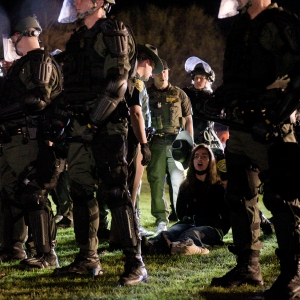Column: Challenges galore for academic leaders
| Published: 09-06-2023 10:42 AM |
Very soon, in a week or so, thousands and thousands of young people would be flocking to campuses across the country hoping to build a bright future for themselves, which would also shape the nation in this age of Generative Artificial Intelligence and MAGA tribalism. Parents would hope and pray that their children would stay safe and healthy on the campuses; and when they graduate, the world be their oyster.
On the other hand, never have academic leaders faced such unusual challenges as today. Not only are they expected to open up new frontiers of knowledge in climate science, space, medicine, and geopolitics; but more importantly, they need to realize that it’s the moral obligation of academic leaders to make their campuses free from fear. Out of irrational fear, men burned women as witches, Justice Louis Brandeis said long ago.
Overt and covert racism, sexism, homophobia, and other forms of discrimination can create an atmosphere of fear on university campuses. According to a 2021 survey by the Association of American Colleges and Universities, the majority of students reported experiencing some form of discrimination based on their gender, race, or ethnicity. The survey also found that students of color are more likely to experience discrimination than white students.
Gender discrimination can take many forms, such as sexual harassment, microaggressions, and unequal treatment in the classroom. Racial discrimination such as hurling racial slurs, being treated differently by professors, and feeling unsafe on campus can be psychologically shattering for students. It can lead to stress, anxiety, depression, and a diminished sense of belonging. A sense of alienation can make it difficult to succeed academically and professionally, apart from creating mental health problems.
Mental health issues are a serious problem on university campuses. The high academic pressure, adjustment to new environments, and other stresses can take a toll on students’ mental health. Many campuses do not have adequate mental health services or resources to support students effectively. Dartmouth College has taken a significant step in confronting mental health issues by inviting all seven living U.S. Surgeons General to address the nation’s mental health crisis in late September. The follow-up actions would be more important.
Last year Fortune reported that “60% of college kids are living with mental health disorders, and schools are woefully unprepared.” The most common mental health conditions among college students are anxiety and depression. The survey also found that “Women in college are far more likely to report a diagnosis than men: 67% compared with 51%.”
There are myriad reasons why mental health issues are so prevalent on university campuses. College students are often juggling many responsibilities, such as classes, extracurricular activities, and part-time jobs. They may also be away from home for the first time, which can be a major adjustment. Another reason for the high rates of mental health problems among college students is the drinking culture on many campuses. Alcohol abuse is a major risk factor for mental health problems, such as depression and anxiety.
Let’s not forget that college students are at a transitional stage in their lives, trying to make new friends, and figuring out who they are. This can be a time of great stress and uncertainty, which can lead to mental health problems. Despite increasing awareness, mental health stigma is still a barrier that prevents many students from seeking help. This stigma can deter individuals from discussing their struggles openly and seeking the necessary support. In some cases, it leads to suicide. Therefore, in spite of privacy concerns, unobtrusive and benign surveillance is a compelling necessity on campuses.
Article continues after...
Yesterday's Most Read Articles
 They remember Vietnam protests. Now, they're facing charges after protesting the Gaza war at Dartmouth.
They remember Vietnam protests. Now, they're facing charges after protesting the Gaza war at Dartmouth.
 Homeless Upper Valley couple faces ‘a very tough situation’
Homeless Upper Valley couple faces ‘a very tough situation’
 NH search crew finds remains of long-missing hiker in remote wilderness area
NH search crew finds remains of long-missing hiker in remote wilderness area
 Bears girls finish first in CVC Championships
Bears girls finish first in CVC Championships
In fact, student suicide is a very serious issue. The reasons behind student suicide can be complex and multifaceted, often involving a combination of high academic expectations, social pressures, mental health challenges, and personal factors. Losing a child to suicide on campus can be devastating for parents. So is the issue of campus rape.
According to RAINN (Rape, Abuse & Incest National Network), sexual violence on campus is widespread. For example, “13% of all students experience rape or sexual assault through physical force, violence, or incapacitation.” One would think that older and more mature students would take care of themselves. But that’s not so, because according to the report, “Among graduate and professional students, 9.7% of females and 2.5% of males experience rape or sexual assault through physical force, violence, or incapacitation. Among undergraduate students, 26.4% of females and 6.8% of males experience rape or sexual assault through physical force, violence, or incapacitation. 5.8% of students have experienced stalking since entering college.” But these problems are not new. They had been shoved under the rug because male-dominated campuses wouldn’t allow them to show up lest their reputation be damaged.
One of the biggest challenges for top academic leaders today is to free the faculty from the irrational fear of Generative AI, a transformative technology that holds the prospects of revolutionizing the way we educate our students, including the modes of teaching through lectures, seminars, case methods, and labs and tutorials; and assessment and evaluation through examinations, essays, and research papers—based on 10-week/15-week quarter/semester cycles.
Whether we like it or not, students are going to use AI-GPT tools. How much can students learn on their own with AI-GPT tools and at what point would they need further instructions from their professors? What does it mean to be a scholar, an expert, or a creator in the age of ChatGPT and Dall-E? These are some of the questions which a university president as the chief academic leader should ask his or her faculty on the opening day of the school.
Narain Batra is affiliated with the Graduate College at Norwich University. Early November, under the auspices of Osher at Dartmouth, he is set to give a public lecture, OUR FREEDOMS AND THE AGE OF ARTIFICIAL INTELLIGENCE.





 Editorial: Response to campus protests only adds fuel to the fire
Editorial: Response to campus protests only adds fuel to the fire Editorial: Chris Sununu’s moral vacuum
Editorial: Chris Sununu’s moral vacuum Editorial: Gambling tarnishes America’s sporting life
Editorial: Gambling tarnishes America’s sporting life By the Way: A white nationalist’s many mistruths
By the Way: A white nationalist’s many mistruths
